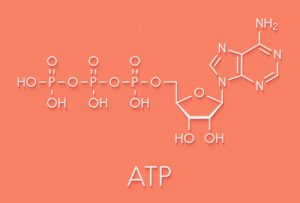
Every person is unique!
Our experienced team will be happy to advise you in detail and free of charge on all matters relating to your health. Book your consultation appointment now:
Adenosine - Occurrence and effect
January 23, 2022
Dipl.-Biol. Dorothee Ogroske et al.
Adenosine is a basic building block of ATP (adenosine triphosphate). ATP is the energy supplier of all cells and also a building block of DNA. Adenosine also functions as a neurotransmitter with a similar molecular structure to caffeine, occupying the same receptors but not stimulating them. It is also a building block of some coenzymes. In turn, a building block of adenosine is adenine. A derivative of this is the eritadenin contained in shiitake.
Physiological effect in the body
ATP is broken down during all energy-consuming processes in the body. Thus, adenosine is then released. In the nervous system, adenosine occupies certain receptors, blocking invigorating substances such as caffeine or activating neurotransmitters such as dopamine, acetylcholine or norepinephrine.
 There is a feedback effect: the more active the nerve cells, the more ATP is consumed and the more adenosine is produced. As a result, more receptors are occupied, the nerve cells work more slowly and the brain is protected from “overwork”. In addition, the blockade of activating neurotransmitters leads to a dilation of blood vessels with a subsequent reduction in blood pressure.
There is a feedback effect: the more active the nerve cells, the more ATP is consumed and the more adenosine is produced. As a result, more receptors are occupied, the nerve cells work more slowly and the brain is protected from “overwork”. In addition, the blockade of activating neurotransmitters leads to a dilation of blood vessels with a subsequent reduction in blood pressure.
Glycolysis and lipolysis
However, the increase in adenosine also stimulates glycolysis. In this way, the availability of energy is increased. On the other hand, adenosine has an inhibitory effect on lipolysis.
Aggregation inhibition and vasodilatation
Adenosine can block thrombin and vasopressin. This leads to platelet aggregation inhibition and vasodilatation via smooth muscle relaxation.
Effect in liver and lungs
Adenosine also exerts a protective effect against oxygen deficiency in the liver through vasodilatation. Furthermore, adenosine causes bronchodilation (dilation of constricted bronchi) in the lungs.
Regulation of immune and inflammatory processes
Adenosine functions as an endogenous regulator of immune and inflammatory processes. It inhibits neutrophil granulocyte activation, phagocytosis, and production of some toxic byproducts of the inflammatory process, preventing excessive damage.
Antioxidant
Adenosine has also been shown to protect against oxygen free radicals, which are formed during normal oxidative metabolic processes and especially in states of hypoxia or ischemia.
Pain relief
Adenosine is also thought to have analgesic properties. Eritadenine is responsible for the cholesterol-lowering effect of shiitake.
Occurrence of adenosine in certain fungi
Adenosine, along with polysaccharides and triterpenes, is responsible for the adaptogenic properties of fungi. Adenosine increases the supply of energy, counteracts overstimulation of the nervous system and relaxes smooth muscles. Adenosines have been specifically identified in the following mushrooms to date: Agaricus blazei murrill (ABM), Auricularia, Cordyceps (cordycepin), Reishi and Shiitake (eritadenin).
DO YOU HAVE ANY QUESTIONS?
We will gladly take time for you. In our free consultation, we answer all your health questions individually and personally. We are looking forward to meeting you!
Scientific studies / sources
- Willard, T.: “Reishi – The Miracle Mushroom of the Ancient Chinese”; Heyne Verlag, 1999.
- Klotz, Prof. Dr. Karl-Norbert: “A2B Adenosine Receptors in Cardiovascular Pathology from Medicinal Chemistry to Molecular Genetics”; University of Würzburg
